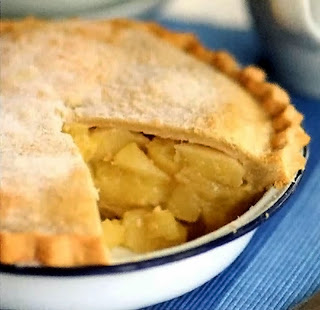The use of pears seems to be a particularly British twist. It was common to use pears in pies during Tudor and Elizabethan times and raised pear pies were particularly enjoyed in London. It is very likely that Shakespeare would have partaken of these pies (for recipes, see this page of Tudor and Elizabethan recipes).
The recipe here is a modern version of these traditional pies that blends both pear and apple for the filling. The filling is purposely kept quite dry so that the pie can be sliced and lifted from its dish.
Deep Pear and Apple Pie
Serves: 8Ingredients:
For the Pastry:
350g (3/4 lb) fine plain flourpinch of salt
175g (7 oz) unsalted butter, finely diced
cold water, to mix
For the Filling:
500g (1 lb) Bramley apples, peeled, cored and sliced thickly500g (1 lb) dessert pears, peeled, cored and sliced thickly
50g (2 oz) sugar (or to taste)
For the Glaze:
1 tbsp milk1 tbsp caster sugar
Method:
Begin with the pastry. Sift together the flour and salt into a bowl. Add the butter and rub into the flour with your fingertips until the mixture resembles fine crumbs. Using a knife, mix in just enough ice cold water to bring the ingredients together as a stiff dough. Bring the pastry together as a ball, wrap in clingfilm (plastic wrap) and set aside in the refrigerator to rest as you prepare the filling.Combine the apples and pears in a pan with 1 tbsp water and sugar, to taste. Bring to a simmer, cover and cook gently for about 5 minutes, or until the fruit just begins to soften. Take off the heat and set aside to cool.
Take 2/3 of the pastry and roll out until large enough to cover the base and sides of a deep pie dish. Use the cooled apple and pear mix to fill the pastry then roll out the remaining pastry and form into a lid. Use this to cover the pie. Flute the edges to crimp then trim off any excess.
Form steam holes in the centre, then brush the top with milk before sprinkling over the caster sugar.
Transfer to an oven pre-heated to 170ºC (350ºF, Gas Mark 5) and bake for about 35 minutes, or until the pastry is golden brown.
This can be served hot or cold and makes an excellent dessert, served with custard, ice cream or cream.
For more information on historic apple and pear varieties and the types that would have been used from the Medieval period, through Shakespeare's time to Victorian times, see this page on historic foods and varieties.










No comments:
Post a Comment